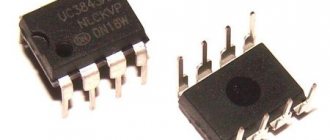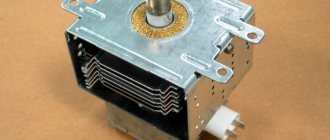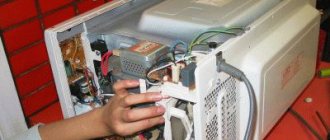Microwave ovens are actively used in every home for cooking and heating food. However, the owners do not understand at all how exactly this equipment works. Therefore, when the device fails, repair difficulties arise. A magnetron for a microwave oven is a source of microwave waves, which, in fact, provide heating of food. Failure of this component is one of the most common types of microwave oven malfunctions. Now we will take a closer look at what a microwave magnetron consists of, how it works and methods for restoring this part.
Principle of operation and design of the magnetron
The word "magnetis" is literally translated from Greek as "magnet". The structure of a microwave oven magnetron looks like this:
- a copper part in the shape of a cylinder is an anode-resonator;
- the element inside which the filament is located - the cathode;
- The ring-shaped components located at the ends of the magnetron for a microwave oven are magnets.
The key principle of operation of a magnetron in a microwave oven is the inhibition of electron flows that intersect at an angle of 90 degrees. This process occurs in magnetic and electric fields. Ring magnets form a field. A special casing equipped with a flange acts as a conductor. It is with the help of this element that the part is attached to the waveguide.
Microwave waves appear as a result of the interaction of the electron flow formed by the emitted cathode and the magnetic field. A wire loop identifies these waves and then transmits them outward using a special antenna. This emitter is located inside a cylinder made of ceramic. Now you know what a magnetron is and how this component works.
As mentioned earlier, the antenna acts as a wave emitter - this is a small pipe, which is usually called a rod. The antenna also pumps air out of the lamp. A cap made of metal is securely fixed to this element. During operation, the magnetron in the microwave becomes unusually hot. The possibility of overheating is eliminated due to the special design.
The component in question is supplemented with a plate radiator. This element is constantly blown by a fan, which significantly reduces the temperature. Temperature fuses provide an additional level of protection against overheating. An integral component is also a high-frequency filter that prevents radiation penetration. This part is created using special capacitors and outputs.
Now you know how a magnetron works in a microwave. It is obvious that this is an electronic device with an unusually complex and multi-level design. Only an experienced craftsman can disassemble the part without damaging it. Therefore, after diagnosing the failure of a component, it is advisable to contact a service center to eliminate the possibility of aggravation of the malfunction.
However, the presence of special equipment and superficial knowledge of radio electronics allows you to repair a microwave oven yourself at home. There is only one condition - adhere to expert recommendations and act strictly in accordance with step-by-step instructions.
Turntable motor
To fully implement the functions of the turntable, its drive motor must have low rotation speeds and a fairly large amount of torque. At the same time, to reduce the cost of the furnace, it should be technologically simple to manufacture and powered from an alternating voltage source.
Modern microwave ovens use a low-power synchronous motor for these purposes (Figure 1). A synchronous motor consists of a stator, which is one circular winding, wound on a frame in the form of a ring and a rotor, which is a permanent magnet. The power of such a motor is not large and is approximately 4 W, and the number of rotor revolutions is equal to the frequency of the supply network current. To reduce engine speed and increase torque, such engines are equipped with a gearbox located in the same housing with the engine elements. The result is a fairly compact device with a low number of revolutions - 5 - 6 revolutions per minute and with a very large output force, capable of turning a pallet loaded with products weighing several kilograms for a long time.
The motor winding is wound with copper wire on a round plastic frame. For ease of power supply, the ends of the winding are brought out under flat terminals. The winding frame is placed at the bottom of a round metal casing, in the center of which is the rotor axis. The rotor consists of a cylinder, which is a permanent magnet. A plastic sleeve is pressed into the center of the cylinder - acting as a bearing. To interact with the gearbox, the rotor shaft is equipped with a toothed gear. The motor winding is fixed on top by a metal plate, which at the same time serves as the base of the gearbox.
The plate contains steel axles on which the gears of the gearbox rotate. To ensure smooth operation and prevent premature wear of parts, the gear mechanism is generously lubricated with lubricant. To protect against external influences and dust getting inside, the entire engine structure is tightly closed with a metal cover (Figure 2).
Turntable motors produced by modern industry may differ from each other, both in the design of the gearbox - this is, first of all, the shape of the output shaft adapted for a specific type of adapter coupling, and in the parameters of the motor itself, in particular the supply voltage and power. Information about the engine parameters is located on a sticker glued to the bottom of its body (Figure 3).
Malfunctions in the turntable motor can occur both in its electrical and mechanical parts. Most often, as a result of various types of overloads, the engine gearbox fails. In earlier engine models, a gearbox was used whose gears were made of metal. Gearbox gears of modern engines are usually made of plastic, which makes the engine cheaper to manufacture, but has a negative impact on its quality. Plastic gears are less durable than metal ones and are more susceptible to various types of deformation during operation.
A common phenomenon is the curling of the motor shaft (Figure 4). This can happen as a result of overload or artificial braking of the turntable. Be careful when operating your microwave oven! Follow all conditions and recommendations stated in the operating instructions. Do not load the turntable more than required and carefully ensure that the dishes placed in the oven chamber, when rotating the turntable, do not touch the edges of the chamber and thereby slow down the tray. If you have spare parts or an engine with another malfunction, a failed gearbox can be easily repaired. To gain access to the mechanism, you need to bend the four fastening tabs holding the gearbox cover (indicated by yellow arrows in Figure 1), then, using a sharp tool, carefully pry and remove the cover, replace the failed gear and reassemble the engine in the reverse order. When assembling, make sure that the axes of all gears fit into their holes in the gearbox cover.
Malfunctions of the electrical part of the motor include a break or interturn short circuit of the motor winding. You can check the winding for breaks using an ohmmeter. The winding of a motor designed for an operating voltage of 220V is wound with a very thin wire and contains a fairly large number of turns, so the resistance value of such a winding can reach 13 - 15 kOhm. The winding resistance of motors designed for low supply voltages is 30V. and 21V., has a lower value and lies in the range of 100 - 200 Ohm. If the ohmmeter shows “infinity”, the winding is broken.
Causes of magnetron malfunctions
Experts usually identify several main reasons for the failure of the magnetron of a microwave oven:
- Failure of the cap attached to the vacuum tube. Microwave oven owners can replace this component on their own. Find a similar cap on any other magnetron. The installation locations for this part have a standard configuration.
- The heater broke. The component may overheat and fail. This happens due to violation of the rules for operating equipment. For example, it is strictly forbidden to turn on an empty microwave oven. To check the functionality of the microwave, namely its filament, measure the resistance level between the capacitor elements. The serviceability of the component will be indicated by an indicator - from 5 to 7 Ohms.
- The feed-through capacitor is damaged. To diagnose this breakdown, use a tester. If it shows infinite contact resistance, then replace the capacitor immediately.
It is due to these reasons that the magnetron in the microwave stops working. Now let's take a closer look at how exactly this malfunction manifests itself.
Some tips for replacement
If it becomes clear that the cause of the breakdown is precisely the magnetron or its individual parts, which cannot be replaced, then the magnetron can be replaced. It is not necessary to take a part from the same manufacturer as a new one. It is enough to make sure that the new and old parts are the same size, and that the connection points are located similarly. The magnetron is connected using two contacts.
Before installation, check 3 points:
- The length of the replacement unit is similar to the length of the old one.
- Both mechanisms have antennas of the same diameter.
- After connection, the magnetron is tightly adjacent to the waveguide; if this is not the case, the radiation will be uneven and some of the power will be lost, in other words, the microwave will not work properly.
Possible faults
We list the main breakdowns:
- During operation, sparks appear, indicating that the cap has burned out. Replacing this component will not be difficult, since all caps have the same configuration.
- The high-voltage diode has broken down.
- No voltage is supplied to the magnetron.
- There is no contact in the fuse that controls the temperature and heating level.
- The filaments have burned out.
- The magnetron for the microwave oven has depressurized due to complex overheating.
- The high voltage capacitor is not working or the fuse is blown.
Check the microwave magnetron to determine the type of problem. Absolutely all of the listed breakdowns can be repaired independently at home, except for depressurization. Now you know how to test a high voltage diode in a microwave. We remind you that repairs should only be carried out by those people who have at least a superficial understanding of radio electronics.
High voltage microwave transformer.
A high-voltage transformer provides power to the microwave magnetron. If the step-up transformer malfunctions, power is not supplied to the high-voltage part of the device, the microwave oven stops generating microwaves and, accordingly, heating food.
What are the signs of a faulty transformer:
- The microwave hums and vibrates during operation
- There is a pungent smell of burning or smoke
- The microwave works, but does not heat
Causes of transformer failure
- Interturn short circuit of windings
- Burnt contact on the connector
- Broken contact at the junction of the terminal with the winding
Interturn closure.
The most common cause of transformer failure is an interturn short circuit, resulting from insulation failure due to overheating. Visual signs of an interturn short circuit of a transformer are severe darkening of the high-voltage winding of the transformer and traces of carbon deposits.
The operation of the microwave is accompanied by a loud hum and a burning smell, while the transformer winding gets very hot.
Visible signs of a faulty transformer
Burnt transformer winding
Burnt out transformer
To prevent such malfunctions, it is recommended not to overheat the microwave; after long-term operation, let it “rest” for about 15-20 minutes. so she can cool down.
Burnt contact on the connector.
A common cause of a faulty transformer is a lack of contact at the junction of the terminals and connectors of the transformer. This happens as a result of poor crimping of the connectors. The place of bad contact begins to spark, the contact surface of the connector gets very hot and burns out, and eventually the contact disappears altogether. The consequences of poor crimping of connectors are shown in the photo.
A break at the junction of the terminals and the winding.
If there is no visible damage to the transformer, but the transformer does not work, there may have been a loss of contact at the junction of the winding with one of the terminals. This happens quite rarely, mainly due to poor quality factory soldering.
Microwave transformer circuit
The microwave power transformer has a primary winding of 220 Volts and two secondary windings, one of which increases from 220 Volts to
2000 Volts required to power the high-voltage magnetron circuit, the second step-down from 220 V to
3.1 V, the so-called “heat winding”, is necessary to power the magnetron anode.
Diagram of the high-voltage part of the microwave
How to test a high voltage transformer with a multimeter
The presence of contact can be checked with an ohmmeter. To check the connection, it is necessary to “ring” the resistance of its primary and secondary and filament windings. Before taking measurements, you need to disconnect all terminals from the transformer.
Primary winding test: 2 to 4 ohms. At the same time, the terminals of the primary winding should not “ring” to the transformer body. If there is a breakdown of the primary winding on the housing, the transformer is faulty.
Checking the secondary winding: from 120 to 200 Ohms. One of the terminals of the secondary winding is fixed to the transformer body, so when “testing” the secondary winding, we touch the metal body of the transformer with one of the tester probes, and the terminals of the secondary winding with the other.
Checking the filament winding: from 0.1 to 1 Ohm. If the filament winding is in good working order, there should be no breakage.
Microwave transformer winding resistance
| Circuit being measured | Resistance |
| Primary winding | from 2 to 4 ohms |
| Secondary winding | from 120 to 200 Ohm |
| Filament winding | from 0.1 to 1 Ohm |
Replacing a microwave transformer
To replace a faulty high-voltage transformer, you need to select a similar part. Microwave transformers have a general operating principle, but they differ in class (see markings 200, 220, 250 class), power and location of mounting fixtures. The power of the transformer must be matched to the power of the connected magnetron.
If the power of the new transformer is less (100-200 watts), then the oven will be slightly underheated; it is necessary to increase the heating time. If the power is greater, nothing bad will happen, the power reserve will increase slightly and, accordingly, the life of the transformer will increase.
1″ :pagination=pagination :callback=loadData :options=paginationOptions>
How to determine a breakdown
To determine the malfunction, turn off the power to the equipment by unplugging the power cable from the outlet. Start with a visual inspection of the inside of the microwave oven. How to check the magnetron and understand what is the source of the problem? Failure of this component is accompanied by the appearance of traces of combustion. This type of diagnostic will let you know if a fuse may have blown.
Before checking the magnetron in the microwave with a multimeter, be sure to do a visual inspection. After all, this is also an effective type of diagnosis.
However, it is impossible to identify hidden hardware faults without special equipment. Remember that you must first disconnect the component, and only then test its functionality. Be sure to follow the simple step-by-step instructions:
- Connect the multimeter probes to the terminals of the part. An infinite value on the tester screen indicates a component failure.
- Check the integrity of the printed circuit board, because many important elements are integrated into it: diodes, varistors and resistors. You don't have to solder all the parts, just test the board.
- Ring the fuse at room temperature. In such conditions, he must give an appropriate signal.
- Check the high voltage capacitor for possible breakdown. In working condition, it gives the multimeter an infinite value. If the part is broken, then almost zero resistance will appear on the screen.
- High voltage diode test. The main obstacle to diagnostics is the serial connection. Inspection is not possible and internal resistance is too high to measure. Therefore, make sure that there is no breakdown in this part using a megger.
Use these instructions and also monitor the appearance of characteristic symptoms in order to promptly detect equipment failure.
Capacitor
A capacitor is an electronic component designed to store electrical charge. The ability of a capacitor to accumulate electrical charge depends on its main characteristic - capacitance. The capacitance of a capacitor (C) is defined as the ratio of the amount of electrical charge (Q) to voltage (U).
The capacitance of a capacitor is measured in farads (F), a unit named after the British physicist Michael Faraday. A capacitance of one farad (1F) is equal to the amount of charge of one coulomb (1C) creating a voltage across the capacitor of one volt (1V). Recall that one coulomb (1C) is equal to the amount of charge passing through the conductor in one second (1sec) with a current of one ampere (1A).
However, a pendant is a very large amount of charge relative to how much charge most capacitors can store. For this reason, microfarads (µF or uF), nanofarads (nF) and picofarads (pF) are commonly used to measure capacitance.
1nF = 0.000000001 = 10-9 F
1pF = 0.000000000001 = 10-12 F
Flat capacitor
There are many types of capacitors with different shapes and internal structures. Let's consider the simplest and most fundamental - a flat capacitor. A flat capacitor consists of two parallel conductor plates (plates), electrically insulated from each other by air or a special dielectric material (for example, paper, glass or mica).
Magnetron repair
Some hardware components cannot be restored. If the magnetron burns out in the microwave, it will have to be replaced. This component cannot be repaired. The cost of original spare parts for a microwave oven is unusually high. Sometimes it is more profitable to buy new equipment. Therefore, it is extremely important to thoroughly check the magnetron with a tester by measuring the voltage.
Next, we’ll look at how to test a magnetron in a microwave using special measuring instruments. We will provide detailed step-by-step instructions. It is possible that only individual elements of the component are damaged, which makes it possible to carry out repairs without major capital investments.
Anyone who has at least a little knowledge of radio electronics and also has access to a regular tester and megger can handle hardware repairs. If you doubt your abilities, then it is better to seek help from a service center staffed by experienced professionals.
Control unit diagnostics
Microwave oven testing will vary depending on the design of the device. It is customary to distinguish several main types of control units:
- mechanical;
- electronic;
- sensory.
The magnetron for a microwave oven is checked with a multimeter. Diagnostics of the control unit is carried out in a similar way. Using this tool, make sure that voltage is supplied to the transformer. If you turn on the timer, having previously selected the operating mode, but there is no voltage, this indicates a failure of the control unit.
The easiest way to repair models is those equipped with a mechanical timer and manual operating mode controls. Start with a visual inspection, and then use a tester to measure the current level at the switch contacts. Such diagnostics allows you to determine: burnt contacts, failed parts, oxidized cables. Replace defective parts.
A microwave with an electronic control unit is more difficult to repair. Perform an initial inspection using the display. If a malfunction occurs, the display will show incorrect information. If the screen does not light up at all, then be sure to make sure that the built-in fuse is intact.
The good thing about the electronic control unit is that each user can start the automatic diagnostic process. Check the detected error code with the values indicated in the special table. This is enough to obtain the necessary information. No multimeter connection required.
The control unit is a radio-electronic module with a rather complex structure. To restore the functionality of this unit, special measuring instruments will be required. If you do not have access to them, contact an authorized service center in Moscow or any other city.
Checking the radio wave emission system
Incorrect operation of hardware components, including the control unit, as well as the magnetron for the microwave oven, indicates the need to check the condition of the elements of the microwave radiation system. It includes a high-voltage transformer as well as voltage shift circuit components. Modern furnaces are equipped with high-voltage MOT transformers. Their design includes three levels of winding:
- primary – 220 V;
- step down – 3 V;
- boost - 2 kV.
To determine a burnt element, you need to sequentially check each winding with a tester. The lowest level of resistance is precisely the step-down winding, which provides heat to the magnetron for the microwave oven. The highest resistance is the high-voltage winding. If a breakdown of the microwave oven is detected, and the user has determined that one or more layers of the winding are broken, replace the transformer.
In no case can we exclude an interturn short circuit, which is observed in the high-voltage winding. A sign of this malfunction will be a low temperature level. The noise may increase significantly during operation of the microwave oven. A conventional multimeter cannot measure the voltage at the output terminals of a given winding. Therefore, you will have to use professional measuring tools. If the fears are confirmed and a short circuit is detected, change the transformer.
Be sure to check all the parts that make up the voltage multiplier system. The magnetron for a microwave oven is a key element of this circuit, but it is far from the only one. It also includes capacitors and diodes. The internal resistance level of a high-voltage diode is very high, and its breakdown cannot be measured with a multimeter. Therefore, you will have to use the megger again. If the part is faulty, then install a new diode.
Be sure to check the capacitor for breakdown. A working component will show resistance close to zero. It will increase significantly in just a few seconds. The resistance of faulty capacitors does not change sharply, since there is no contact with the cover.
It is likely that the oven began to heat food noticeably weaker due to the appearance of a leak between the plates. You can also determine the source of the leak using a megger. Faulty radio elements should be replaced.
Magnetron replacement
If the user is sure that the microwave magnetron is broken, replace this element. This procedure is mainly carried out by qualified specialists. However, everything can be done with your own hands. The main thing is to understand a little about radio electronics, and also know how current voltage is measured.
The replacement procedure in a microwave oven requires that the user first purchases a new component. To make your choice successful, you need to follow a few simple recommendations:
- The power level of the magnetron for a microwave oven fully corresponds to that of a broken device. All necessary information is specified in the technical passport.
- The new part has identical mounting holes, and all contacts match.
- The dimensions of the broken component fully correspond to the dimensions of the new spare part.
Installing a new magnetron for a microwave oven is not difficult. However, the user must achieve the tightest possible fit of the component to the waveguide. Don't forget to check the capacitor.
How to check the magnetron of a microwave oven for serviceability
To correctly determine a microwave malfunction, you need to disassemble the device and conduct a thorough diagnosis. Some hardware components are extremely expensive, so to avoid unnecessary financial waste, pay close attention to the initial inspection. Everyone can figure out how to connect a magnetron to a microwave; repairing this part is much more difficult, since it is impossible. The only way out is to replace the component.
Diagnosis is carried out as follows:
- Turn off the power to the microwave oven by unplugging the power cable from the socket.
- Remove the protective casing of the device.
- Find the broken part, and then remove the terminals from the component's terminals.
- Use a multimeter to measure the voltage of the magnetron, namely its contacts. It should be insignificant. If the indicator is too high, then this indicates a burnt-out filament.
- Measure the voltage between the terminal and the device body.
This completes the check. Now you know how to act.
What is the equipment?
How to check a transformer if we don’t know its design? Let's look at the principle of operation and types of simple equipment. Turns of copper wire of a certain cross-section are applied to the magnetic core so that leads remain for the supply winding and the secondary winding.
Energy is transferred to the secondary winding in a non-contact manner. At this point it becomes almost clear how to check the transformer. The usual inductance is measured in the same way with an ohmmeter. The turns form a resistance that can be measured. However, this method is applicable when the specified value is known. After all, the resistance can change up or down as a result of heating. This is called an interturn short circuit.
Such a device will no longer produce reference voltage and current. The ohmmeter will only show an open circuit or a complete short circuit. For additional diagnostics, use the same ohmmeter to check the short circuit to the housing. How to test a transformer without knowing the winding terminals?
This is determined by the thickness of the outgoing wires. If the transformer is a step-down transformer, then the output conductors will be thicker than the input conductors. And accordingly, vice versa: the input wires of the booster are thicker. If two windings are output, then the thickness may be the same, this should be remembered. The surest way to look at the markings and find the technical characteristics of the equipment.
Microwave oven without tray
A microwave is a complex household appliance, a product of innovative technologies. It’s all the more offensive when you lose it because of such a trifle as a spinning plate. It turns out that this problem can be avoided in advance if you buy a device without a rotating mechanism.
An inverter oven is the most advanced representative of microwave ovens. Its main difference is inverter regulation with a magnetron. One of the advantages of such microwave ovens is the absence of a turntable:
- No moving parts - fewer breakdowns.
- The magnetron is located at the bottom rather than on the side—the volume is used more efficiently. The capacity of the chamber increases. Cooking and defrosting are faster.
- Simplified maintenance and increased reliability.
- You can cook several dishes at the same time in different dishes.
On a note! You will learn more about this technique in the review “Microwave oven without a turntable.”
Before you decide to repair a microwave oven yourself, evaluate your capabilities. There is definitely no need to disassemble a device that is under warranty. Before contacting service or a technician, be sure to check whether there are any obstacles that prevent the rotation of the pallet. When troubleshooting, try not to make the problem worse.
Check out these useful videos that will help you fix the problem yourself:
Why does the plate spin?
The first microwave ovens were not equipped with a rotating tray; they came up with it later. You can’t envy the owners of the first expensive stoves - they manually turned the food, the device had to be turned on at least twice. Later, developers improved the design of the microwave and automated the process - the equipment began to work without human intervention.
To ensure that food was heated evenly, a plate with wheels was introduced into the design. Uniform rotation allows the product to warm up completely in one cycle.
If the plate stops spinning, you can:
- Do nothing and turn by hand. This is not a serious approach; modern equipment should work according to its declared functions, without taking up the owner’s time and without complicating the cooking process.
- Find out why the mechanism does not rotate the pan. When the cause of the malfunction is discovered, take measures to eliminate it.
If the engine breaks down
The most unpleasant reason why a plate does not spin is a broken motor. As mentioned above, replacing the motor is an expensive pleasure, which not every owner of a microwave oven can decide on. It is necessary to first calculate the rationality of such a step. Often the malfunction is associated with a broken gearbox or poor-quality wiring. In any situation, the motor needs to be replaced.
To understand the causes of the malfunction, you need to know the engine structure. Let's take a closer look at the mechanisms that affect the operation of the motor:
Motor shaft. With its help, a rotational movement is produced. Shaft failure can be caused by careless handling or interference with its operation, for example:
- manual braking;
- touching the walls of the chamber with the dishes;
- increased load on the mechanism.
Important! After purchasing a microwave oven, be sure to read the instructions to know how to use it correctly and what loads it can withstand.
Motor housing and gearbox cover. Their job is to prevent water, food particles and foreign objects from getting inside the microwave.
Gearbox. Responsible for the functioning of the rotating element. Gearbox failure rarely occurs - it is a fairly wear-resistant mechanism. When the gears involved in rotation wear out, it breaks.
Attention! Today, microwave ovens use plastic analogues instead of metal gears, which does not contribute to the durability of the gearbox.
To find out the reasons for the breakdown, you need to disassemble the device. First remove the panel covering the engine. Then it is removed and unscrewed with a screwdriver and pliers. Often fat accumulates under the lid - it must be carefully removed without damaging the mechanism. You can use regular alcohol or a special composition. When the fat is removed, it is necessary to lubricate the important components of the motor and secure the housing.
What kind of motor is needed?
For a motor to work fully, it must have low speeds and high torque. It also requires high efficiency and energy efficiency. Microwave ovens use low-power synchronous motors (4 W), making 3-7 revolutions per minute. They can easily turn a plate on which several kilograms are placed.
To replace a broken motor or gearbox, you don’t need any special talents - follow the appropriate video instructions:
When replacing the motor , do not turn the shaft if you touch the power terminals - you may break the gearbox or get an electric shock . When choosing what to replace a broken part with, do not take cheap analogues - they are of poor quality and are unlikely to last long.
Burnout of mica plate
A sure sign of a broken mica plate is the sparks that appear when it is turned on. The reason is improper operation of the oven, that is, heating food with the lid open. With this option, drops of food are sprayed onto the plate. As a result, it gets wet and burns out.
The mica plate is inexpensive and can be purchased at specialized electrical stores. If you find a mica plate of other sizes, then you can use it to make a plate of the required size with your own hands.
If you cannot find a replacement for this part, you can reuse the burnt plate. To do this, you need to remove the plate and carefully clean it of dirt. Next, turn it over with the damaged side inward and carefully place it in place. This repair option, of course, can hardly be called ideal, but it will do just fine until you find a replacement for the damaged part. How to replace the mica plate, watch the video:
You can study the process of replacing parts in detail from our video. Experts explain in detail the troubleshooting technique, how and in what sequence parts need to be changed. Moreover, these recommendations are suitable for both Samsung microwave ovens and microwave ovens from other companies. After all, their design and operating principle are practically the same. If you were unable to fix the problem even with the help of our video, and the oven still does not heat, you can have the microwave oven repaired by specialists or even purchase a new one. It all depends on the level of breakdown and the amount of money you are willing to spend.
Check power
If you find that a plate is broken and the microwave is not heating, it is likely that it is simply not receiving power. Perhaps the wires in the motor are burnt out or the microcircuits are damaged. This problem often happens in homes where there is unstable voltage.
In addition, battery failure can be caused by water getting inside the housing - you will need to deal with the internal block of the stove. Without sufficient electrical knowledge and skills, you should not fix such problems yourself. If you don’t want to break anything else, entrust the work to qualified specialists.
Depending on the causes of the malfunction and the cost of repair, you will make a decision: repair or dispose of it.
The plug has melted
This is what remains of the protection that protects the magnetron waveguide from drops of fat and water.
And this is on the back side of this plug.
I tried to clean it out and melt it back into its original shape, but I worked in vain. I decided to just throw it away. Instead, it is better to cut it out and put it.











